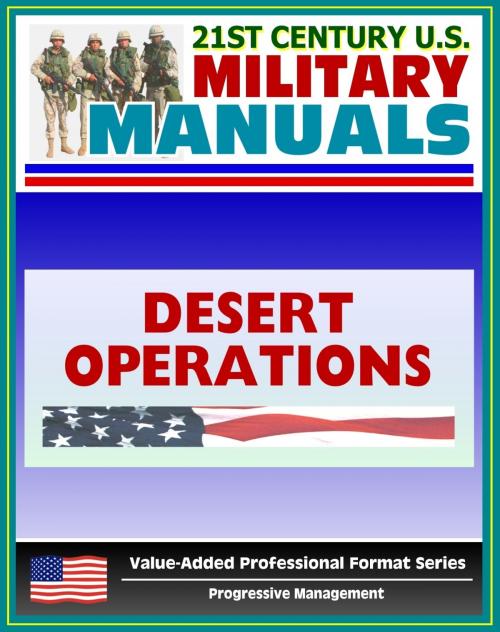21st Century U.S. Military Manuals: Desert Operations Field Manual - FM 90-3 (Value-Added Professional Format Series)
Nonfiction, History, Military, Social & Cultural Studies, Political Science| Author: | Progressive Management | ISBN: | 9781465950161 |
| Publisher: | Progressive Management | Publication: | September 15, 2011 |
| Imprint: | Smashwords Edition | Language: | English |
| Author: | Progressive Management |
| ISBN: | 9781465950161 |
| Publisher: | Progressive Management |
| Publication: | September 15, 2011 |
| Imprint: | Smashwords Edition |
| Language: | English |
Part of our value-added professional format series, the Desert Operations Field Manual (FM 90-3) 27 is the Army's and Marine Corps' manual for desert operations. It is a key reference for commanders and staffs regarding how the desert affects personnel, equipment, and operations. It will assist them in planning and conducting combat operations in desert environments.
Arid regions make up about one-third of the earth's land surface, a higher percentage than that of any other type of climate. As we have seen in the recent past, some of these regions — because of diverse and conflicting cultures, strategic importance, and natural resources - have become centers of conflict.
Military leaders have long recognized the potential for US involvement in conflict in these regions. Exercises at the Army's National Training Center, Fort Irwin and the Marine Corps' Marine Air Ground Combat Center, Twentynine Palms, California, have provided an opportunity for virtually all our ground forces to experience desert conditions. The success of Operation Desert Storm can be directly attributed to this realistic training.
Desert operations demand adaptation to the environment and to the limitations imposed by terrain and climate. Success depends on an appreciation of the effects of arid conditions on soldiers (both physically and psychologically), on equipment and facilities, and on combat and support operations. Leaders and soldiers must continually evaluate the situation and be ready to react to changing conditions. Equipment and tactics must be modified and adapted to a dusty, rugged landscape where temperatures vary from extreme highs to freezing lows and where visibility can change from 30 miles to 30 feet in a matter of minutes.
This field manual has been converted for accurate flowing-text e-book format reproduction.
As a bonus, this reproduction includes FM-1, The Army Field Manual, a capstone manual containing the vision for the Army - sold separately for $5.99. FM 1 establishes the fundamental principles for employing Landpower. The most important of these are the Army's operational concept and the fundamentals that support it. They form the foundation for all Army doctrine. All Soldiers should understand and internalize them. FM 1 describes the American profession of arms, the Army's place in it, and what it means to be a professional Soldier.
This is a privately authored news service and educational publication of Progressive Management.
Part of our value-added professional format series, the Desert Operations Field Manual (FM 90-3) 27 is the Army's and Marine Corps' manual for desert operations. It is a key reference for commanders and staffs regarding how the desert affects personnel, equipment, and operations. It will assist them in planning and conducting combat operations in desert environments.
Arid regions make up about one-third of the earth's land surface, a higher percentage than that of any other type of climate. As we have seen in the recent past, some of these regions — because of diverse and conflicting cultures, strategic importance, and natural resources - have become centers of conflict.
Military leaders have long recognized the potential for US involvement in conflict in these regions. Exercises at the Army's National Training Center, Fort Irwin and the Marine Corps' Marine Air Ground Combat Center, Twentynine Palms, California, have provided an opportunity for virtually all our ground forces to experience desert conditions. The success of Operation Desert Storm can be directly attributed to this realistic training.
Desert operations demand adaptation to the environment and to the limitations imposed by terrain and climate. Success depends on an appreciation of the effects of arid conditions on soldiers (both physically and psychologically), on equipment and facilities, and on combat and support operations. Leaders and soldiers must continually evaluate the situation and be ready to react to changing conditions. Equipment and tactics must be modified and adapted to a dusty, rugged landscape where temperatures vary from extreme highs to freezing lows and where visibility can change from 30 miles to 30 feet in a matter of minutes.
This field manual has been converted for accurate flowing-text e-book format reproduction.
As a bonus, this reproduction includes FM-1, The Army Field Manual, a capstone manual containing the vision for the Army - sold separately for $5.99. FM 1 establishes the fundamental principles for employing Landpower. The most important of these are the Army's operational concept and the fundamentals that support it. They form the foundation for all Army doctrine. All Soldiers should understand and internalize them. FM 1 describes the American profession of arms, the Army's place in it, and what it means to be a professional Soldier.
This is a privately authored news service and educational publication of Progressive Management.















